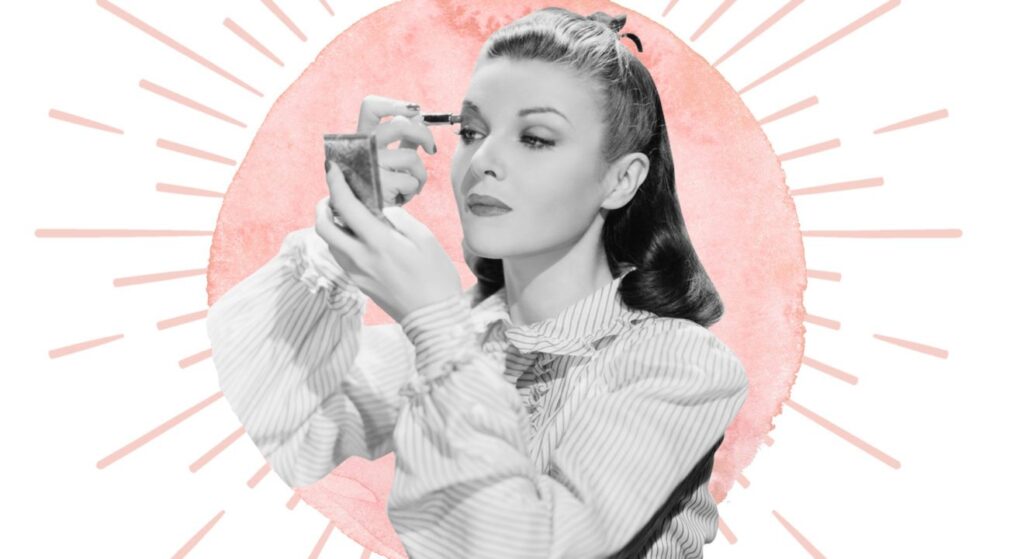By Rania Tsoli,
From using natural products such as fruit and flowers to create pigments for the face and body to composing intricate chemical concoctions in modern cosmetics labs, makeup has most definitely been around for countless centuries. From cosmetics in ancient Egypt and how one’s makeup was done in the Victorian Era to the varying trends of the 20th century decades and what the freedom and power of makeup stand for in our modern world, putting a fresh face of makeup on has surely been one of today’s – ironically – everchanging constants, making daring leaps in terms of progress throughout the years. Where makeup originated from and what its original purposes were are just the tip of the iceberg of how makeup has reached its modern blossoming era.

The very first time period where cosmetics usage was recorded takes us back to 3000 BC during the first Egyptian dynasty. The Egyptian upper classes used makeup in order to decorate their eyes, and therefore be set apart from the lower classes, wanting to in a way announce their social status to the public by creating intricate decorative shapes around their eyes, a technique which, besides flatter them, would also make their eyes look more fierce and powerful. During the Egyptian dynasty, women were not the only ones wearing makeup, however: men also wore equal amounts of makeup daily. Whenever someone thinks about Egyptian makeup, the first colors that would immediately come to mind are black and green: Egyptians made custom black and green eyeshadows by using mined lead and copper ores, while also using a sort of pencil-shaped makeup product known as “kohl” to outline and give shape to their eyes.
In ancient China, people from the upper classes would paint their fingernails instead of decorating their eyes in order to show off their social group, a routine which began circa 3000 B.C. Royals preferred to dye their nails a shade of gold or silver, while poorer and lower classes were not allowed to wear any sort of bright nail color palette. In Japan, on the other hand, Geishas have always been famous for their striking makeup and natural beauty. They originally used lipstick that they made from crushed safflower petals; the concoction that they also came up with in order to paint their eyebrows. For more official ceremonies, a black paint called “ohaguro” was (and still is) used to color one’s teeth.

If we dig even deeper, Alexander the Great also famously wore makeup for both aesthetic purposes as well as health reasons. Special eye makeup was used to protect the delicate skin around the eyes, keep off any flies or insects, and ultimately shelter the eyes from the sun’s glare, working like a sort of modern sunscreen. In fact, while traveling through Asia, Alexander would send plant cuttings home to a friend of his in Athens so that they could create a garden made especially for makeup, health, and beauty products.
During the Middle Ages, makeup would quite often be conceived as heavily immoral. In fact, the Church did not allow the use of makeup, simply because it was considered to express — or hide — immorality. However, even though makeup was prohibited at the time, women still kept using various forms of it in Europe. At one time, women would crush fresh geranium petals and rub them on their lips and cheeks in order to create a rosy glow. Moving a bit more forward on our time-traveling journey, the well-known Victorian Era lasted from 1837 to 1901. During that time, any use of cosmetics was mostly associated with female actresses and prostitutes. People cherished the natural skin color and the radiance behind it, while anyone that altered that natural color and its natural beauty and slight puffiness was a bit frowned upon.

During this time, women also started to tweeze their eyebrows, massage castor oil into their eyelashes in order to help them grow longer and stronger, and use rice powder to dust their noses. In order to achieve a flushed look, they often used beet juice or simply turned to pinch their cheeks to give them a rosier appearance. Finally, a clear pomade with a texture like that of a modern lip gloss was used to give the lips a glossy sheen.
It was not until the beginning of the 20th century that makeup became more socially accepted and finally started gaining some popularity. This popularity very soon led to the true evolution of makeup as we know it today, as well as the availability of the first commercial cosmetics. In the 21st century, we can finally say that makeup truly is for everyone, while feeling more and more secure with that choice and statement. It is not that rare of a sight to see men quickly catching onto products such as concealer, mascara, and eyeliner, so as to enhance their own features. As gender equality movements progress, the lines between who “can and cannot” wear makeup – along with gendered perfume, clothes, etc. — are becoming ever more blurred, something which in my opinion is definitely for the better. Now more than ever, makeup is finally seen not as a way to hide insecurities, but as a powerful tool of self-expression and, ultimately, self-love.
References
- 4000 Years of Makeup: The Evolution of Makeup, Imi.edu, Available here
- How Makeup Has Changed Over the Time, evergreenbeauty.edu, Available here
- The evolution of: makeup, readersdigest.co.uk, Available here




